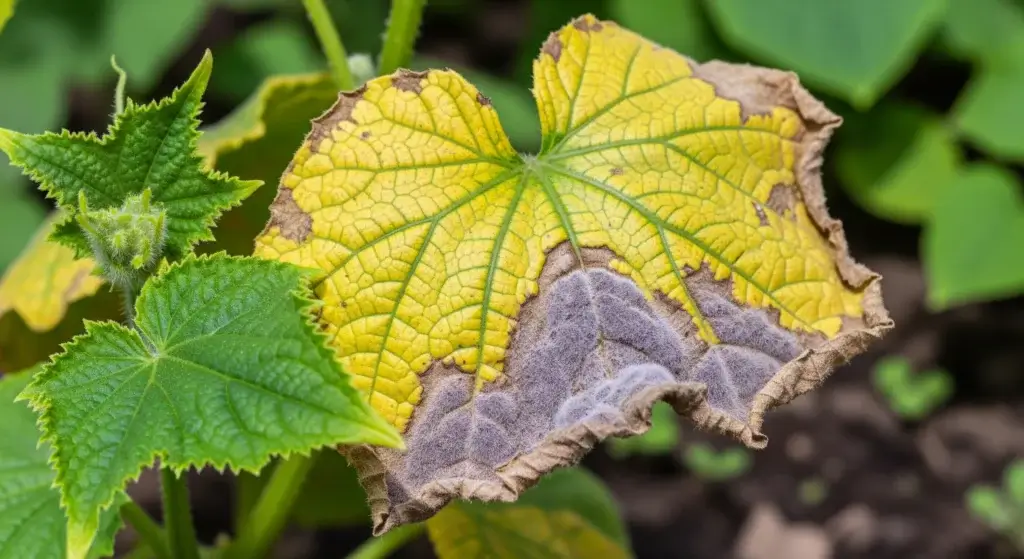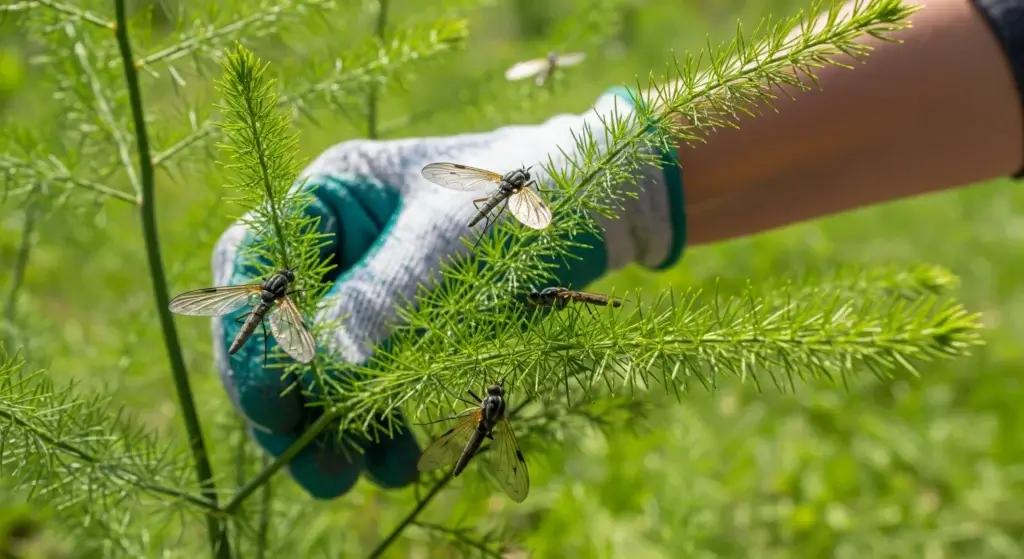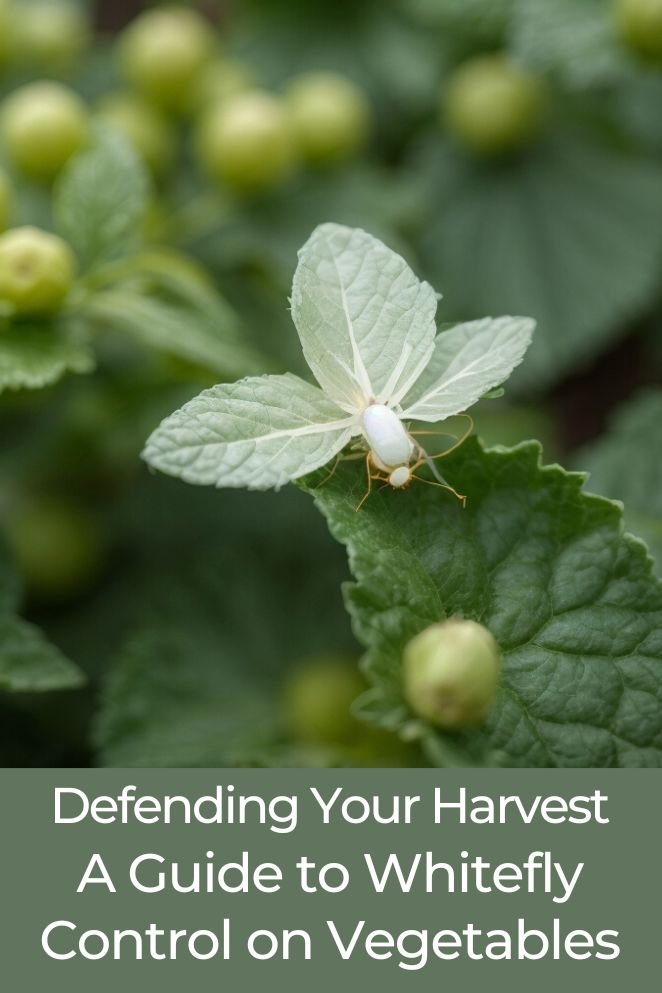
Whiteflies pose a significant challenge for vegetable gardeners. These small flying pests can cause considerable damage to plants.
However, don’t worry!
This guide will thoroughly cover whiteflies, including their life cycle, the harm they inflict, and, most importantly, effective control methods.
What is Whitefly?
Whiteflies, despite their name, aren’t actually true flies.
They fall under the insect order called “Hemiptera,” which also includes aphids and scale insects.
These pests are quite small, measuring about 1/16 to 1/10 of an inch in length, and they have a distinctive white, powdery appearance when flying due to their waxy wings.
Whiteflies have a habit of feeding on the sap of plants using their piercing-sucking mouthparts.
This feeding action puts stress on the plants, impeding their growth and overall health.
Additionally, whiteflies can serve as carriers for plant diseases, acting as vectors for viral infections that can harm various vegetable crops.
- Read also: How To Make a Natural Pesticide
- Read also: Natural Pest Control Methods for Your Vegetable Garden
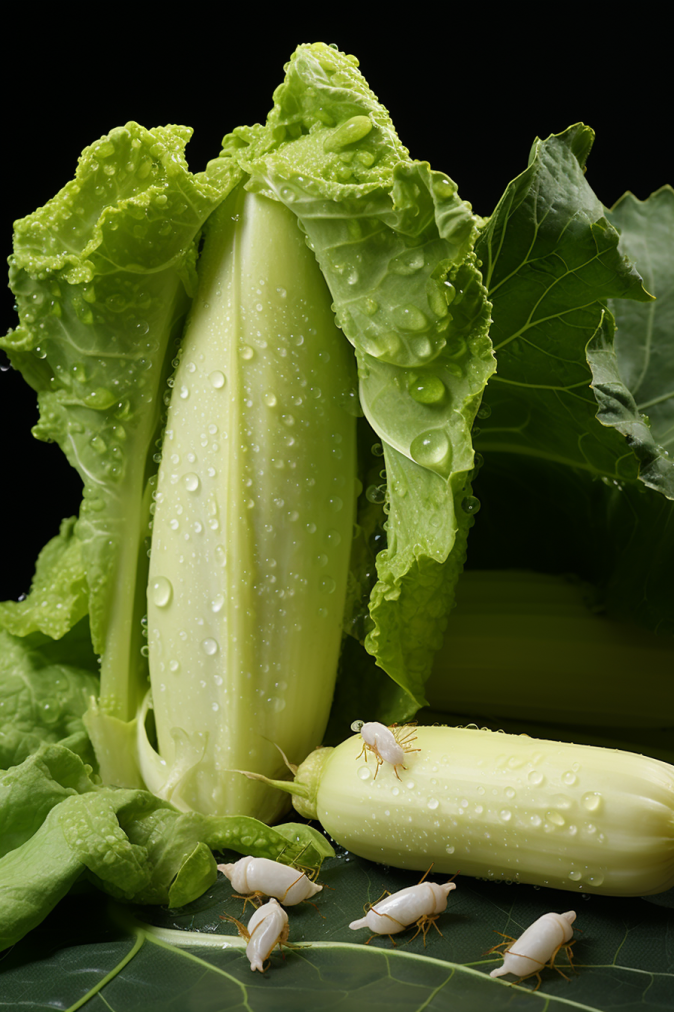
Life Cycle of Whitefly
Stage 1: The oval egg
Whiteflies start their life cycle as eggs, which are typically laid on the undersides of leaves in circular patterns.
These tiny, oval-shaped eggs are often barely visible to the naked eye and can range in color from whitish to yellowish.
Stage 2: Nymph
Upon hatching, the eggs give rise to nymphs.
Nymphs are tiny, almost transparent, and initially immobile.
They gradually become more active and develop through several nymphal stages, feeding on the plant’s sap during this phase.
Nymphs tend to cluster on the underside of leaves, where they’re shielded from predators and environmental factors.
Stage 3: Pupa
After undergoing several nymphal stages, the whitefly enters the pupa stage.
Pupae are relatively inactive and usually covered by a waxy secretion.
They undergo internal changes and metamorphosis within this stage before emerging as adults.
Stage 4: Adult
Once the metamorphosis is complete, adult whiteflies emerge from the pupal casings.
These adults have the characteristic white, powdery wings and are capable of flight and reproduction.
They resume feeding on the plant’s sap and begin the cycle anew by laying eggs, thereby perpetuating the life cycle.
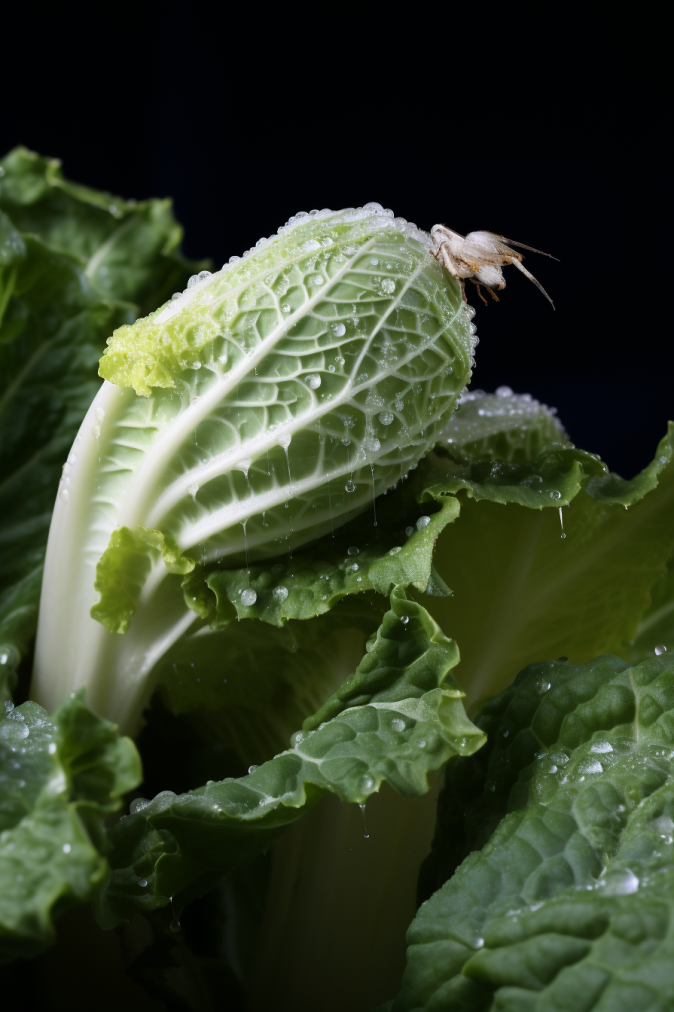
Different Types of Whiteflies
Greenhouse whitefly (Trialeurodes vaporariorum)
Adults are typically small, measuring about 1.5 to 2 millimeters in length.
Adults have a pale-yellow body and wings, giving them a white or pale appearance. Their wings are held roof-like over the body when at rest.
This species has a broad appetite, affecting a wide range of vegetables such as tomatoes, cucumbers, and brassicas (cabbage, broccoli, etc.).
Greenhouse whiteflies thrive in warm environments, making them a common pest in indoor cultivation and greenhouse settings.
Silverleaf whitefly (Bemisia tabaci)
Adults are tiny insects, measuring approximately 1.2 to 1.5 millimeters in length. They possess a distinctive white or silver coloration, which is most noticeable when in flight.
Known for its versatility, the silverleaf whitefly infests numerous crops, including vegetables, fruits, and ornamental plants.
Cotton, tomatoes, beans, and melons are highly vulnerable to infestations by silverleaf whiteflies, which favor these crops as their preferred hosts.
Sweet potato whitefly (Bemisia tabaci biotype B)
The sweet potato whitefly, specifically biotype B of Bemisia tabaci, is a small insect with a length ranging from 0.8 to 1.2 millimeters.
Its physical characteristics include a yellowish body and wings, making it distinguishable from other whitefly species.
The sweet potato whitefly has a distinct preference for ornamental plants and crops like sweet potatoes, poinsettias, and hibiscus.
This whitefly is known for rapidly reproducing in warm conditions, leading to quick population explosions.
Giant whitefly (Aleurodicus dugesii)
Adults typically measure around 3 millimeters in length, making them notably larger in comparison.
Adult giant whiteflies exhibit a distinctive powdery white or light gray coloration, contributing to their easy identification.
Their wings may have a slightly transparent quality, adding to their unique appearance.
This whitefly targets a variety of woody plants, including citrus trees, hibiscus, and other ornamental shrubs.
Bandedwing whitefly (Trialeurodes abutiloneus)
The bandedwing whitefly, scientifically known as Trialeurodes abutiloneus, is a small insect with adults measuring approximately 1.5 millimeters in length.
Adult bandedwing whiteflies have a predominantly white or pale yellow body.
The dark band on their wings sets them apart from other whitefly species, aiding in visual identification.
This whitefly is commonly found on ornamental plants such as hibiscus, geraniums, and poinsettias.
Rugose spiraling whitefly (Aleurodicus rugioperculatus)
The rugose spiraling whitefly, with adults measuring around 2 to 3 millimeters in length.
Their appearance is characterized by a distinctive, waxy, spiraled pattern on their wings, contributing to their unique identification.
Adult rugose spiraling whiteflies typically have a light yellow or pale coloration, and their wings exhibit a pronounced spiraled pattern.
Ornamental trees like gumbo-limbo and live oak are frequent victims of this whitefly species.
How Can Whitefly Damage the Vegetable Plant?
Direct damage
Sap sucking
Employing their specialized mouthparts, whiteflies pierce various parts of plants such as leaves, stems, and fruits to extract sap. This feeding behavior results in the deprivation of essential nutrients and water from the plant, leading to:
- Stunted growth: The presence of whiteflies can lead to stunted growth, observable through smaller leaves, thinner stems, and an overall slowdown in plant development.
- Leaf yellowing and curling: Nutrient deprivation from whitefly feeding induces a loss of green color in leaves, resulting in yellowing. Additionally, affected leaves may exhibit curling or distortion.
- Leaf drop: Severe infestations weaken plants to the extent that leaf drop becomes a defensive mechanism for conserving energy.
- Fruit discoloration and scarring: Whitefly feeding on fruiting vegetables can cause undesirable effects, including discoloration and scarring.
Honeydew
While engaged in feeding, whiteflies release a sweet substance known as honeydew. This sticky substance:
- Invitation for ants: The sweet honeydew emitted by whiteflies serves as a lure for ants, potentially disrupting the activities of natural predators essential for managing whitefly populations.
- Encourages sooty mold development: Honeydew acts as a substrate for the growth of sooty mold, a dark fungus that forms a barrier to sunlight, impeding the process of photosynthesis.
Indirect damage
Transmission of viruses
Certain whitefly species, such as the silverleaf whitefly, act as carriers for plant viruses.
These insects can acquire viruses from infected plants and subsequently transfer them to healthy plants while feeding.
The introduced viruses may result in various diseases, manifesting as:
- Leaf chlorosis or mottling: Leaves may display patterns of yellowing, mottling, or discoloration.
- Stunted growth or malformation: The virus can disrupt normal plant growth and development, leading to stunted growth or the deformation of leaves and fruits.
- Yield reduction: Viral infections can significantly diminish both the quality and quantity of harvested vegetables.
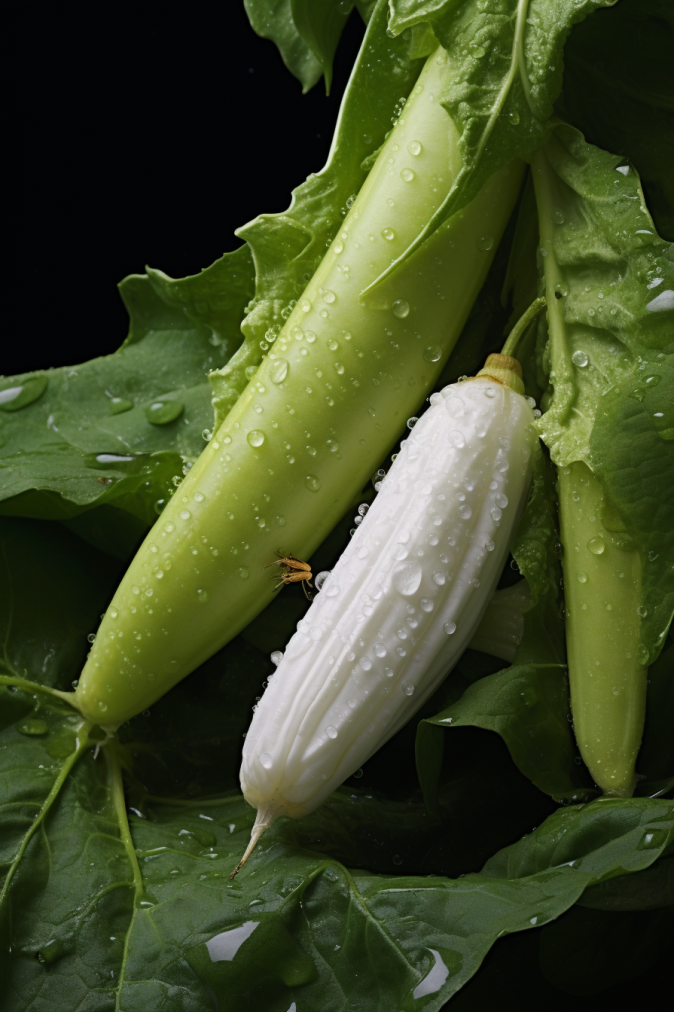
Organic Control Methods for Whitefly
Physical removal
Water blast
Revitalize your infested plants by administering a thorough water blast using a robust hose jet.
This straightforward method effectively dislodges and submerges delicate whiteflies, especially the vulnerable nymphs that often cling to the undersides of leaves.
Biological controls
Microbial insecticides
Products containing beneficial microorganisms like Beauveria bassiana can be applied to the soil or foliage to control whitefly populations organically.
Beneficial insects
Ladybugs
Invite these delightful beetles to your garden—they have a hearty appetite for whiteflies.
Encourage their presence by planting flowers that appeal to them, such as dill, cilantro, and cosmos, in close proximity to your affected plants.
Lacewings
These delicate beauties boast larvae with a particular talent for eliminating whiteflies at every stage, from eggs to nymphs.
Foster their presence by offering shelter, either through lacewing houses or by cultivating herbs like dill and fennel.
Creating a hospitable environment ensures the flourishing of these natural whitefly assassins in your garden.
Hoverflies
Meet the hoverflies—bee impersonators with a penchant for pollen and nectar. What’s intriguing is that their larvae feast on whiteflies.
To enlist these natural allies in your garden, cultivate flowering herbs and companion flowers.
These not only entice hoverflies but also support the proliferation of their larvae, which are adept at annihilating aphids, including the troublesome whiteflies.
Cultural practice
Companion planting
Strategically planting crops that naturally repel whiteflies or attract their predators can create a more balanced ecosystem in your garden.
- Marigolds: Planting marigolds in proximity to vulnerable crops can act as a deterrent for whiteflies. The strong scent of marigolds can confuse and repel these pests.
- Nasturtiums: These flowers not only serve as a natural barrier but also attract predatory insects that prey on whiteflies.
Crop rotation
Regularly changing the location of susceptible crops can disrupt the life cycle of whiteflies and reduce the risk of infestation.
Botanical solutions
Neem oil spray
Applying neem oil sprays acts as an effective organic insecticide. Neem oil disrupts the life cycle of whiteflies and inhibits their feeding, ultimately reducing their numbers.
Garlic spray
A homemade garlic spray, when applied to plants, can act as a repellent for whiteflies. The strong odor deters them from settling on the plants.
Traps
Yellow sticky traps
Whiteflies, drawn to the alluring yellow color, mistake these sticky traps for flowers.
Placing them in proximity to infested plants effectively lures and traps adult whiteflies.
Regular replacement of filled traps ensures continuous control.
Reflective mulches
Crafted from aluminum or silver plastic, reflective mulches play a crucial role in repelling whiteflies.
By reflecting sunlight, these mulches disorient the whiteflies, impeding their navigation and making it challenging for them to land on your plants.
Chemical Control Methods for Whitefly

Insecticides
Type of insecticides
Contact insecticides
Contact insecticides are designed to eliminate whiteflies upon direct contact.
However, they necessitate thorough application and repeated treatments because their effectiveness diminishes quickly.
Notable examples of contact insecticides include pyrethrins and insecticidal soap.
Systemic insecticides
Systemic insecticides function by being absorbed by plants, and traveling through their vascular systems.
This results in the death of whiteflies that feed on these plants.
Examples of systemic insecticides encompass imidacloprid and dinotefuran.
Understanding the distinction between these two types of insecticides aids in choosing the most suitable approach for managing whitefly infestations in a garden or agricultural setting.
Effectiveness
Both types of insecticides can be effective in quickly reducing whitefly populations, especially with systemic insecticides.
Downsides
- Harm beneficial insects: Using insecticides can harm beneficial insects like ladybugs and lacewings, disrupting the natural balance of the ecosystem. This is because these substances not only target pests but also impact the predators essential for maintaining ecological harmony.
- Environmental impact: The environmental repercussions of insecticide use are significant. Residues from these chemicals can contaminate soil and water, posing threats to various organisms within the ecosystem.
- Resistance: Another concern is the development of resistance in whiteflies against insecticides over time. This often necessitates the use of stronger chemicals or more frequent applications, contributing to a cycle of escalating interventions.
- Human health risks: There are potential risks to human health and pets if insecticides are not used properly. It’s crucial to exercise caution and follow recommended guidelines to minimize any adverse effects on human and animal well-being.
Insect growth regulators (IGRs)
Insect growth regulators (IGRs) work by interfering with the molting process of young whiteflies, hindering their transition to adulthood and their ability to reproduce.
Notable examples of IGRs include buprofezin and pyriproxyfen.
This approach targets the developmental stages of whiteflies, aiming to disrupt their life cycle and control their population in a more targeted manner.
Effectiveness
Can provide long-term control by preventing population growth.
Downsides
- Slower acting: Insect growth regulators (IGRs) exhibit a slower response, often requiring several weeks to show noticeable results.
- Less effective on adults: They are particularly effective against the nymphs and eggs of whiteflies, with less impact on the adult population.
- Similar downsides to insecticides: They have the potential to harm beneficial insects and contribute to environmental concerns. Despite their targeted approach to whitefly control, careful consideration of their broader impact is essential in maintaining a balanced and healthy ecosystem.
Conclusion
Successfully managing whiteflies in your garden requires employing effective strategies.
By implementing a combination of preventive measures, organic solutions, and judicious use of chemicals, you can effectively keep them in check.
It’s crucial to bear in mind that maintaining a healthy garden involves a thoughtful approach that balances these methods.
Regularly employing preventive measures, incorporating organic solutions like beneficial insects and careful use of substances, ensures a thriving garden.
This comprehensive strategy, tailored to your garden’s needs, is key to dealing with persistent whitefly challenges.
- Read also: Flowers for Vegetable Garden Pest Control
- Read also: Cabbage Aphid Control: Effective Strategies for a Healthy Garden
Frequently Ask Questions
Certainly! You can manage whiteflies without turning to pesticides. Beneficial insects like ladybugs and lacewings, paired with natural solutions like neem oil, offer effective alternatives for whitefly control, emphasizing a pesticide-free approach.
Whiteflies themselves do not pose a direct danger to humans. However, their existence can indirectly affect human well-being by diminishing the yield and quality of vegetable crops.
It’s crucial to keep a close eye on your plants. Make it a habit to inspect them every week, paying special attention to the undersides of leaves. Whiteflies tend to conceal themselves and lay eggs in these areas. Regular monitoring helps catch any issues early on and ensures the health of your plants.


